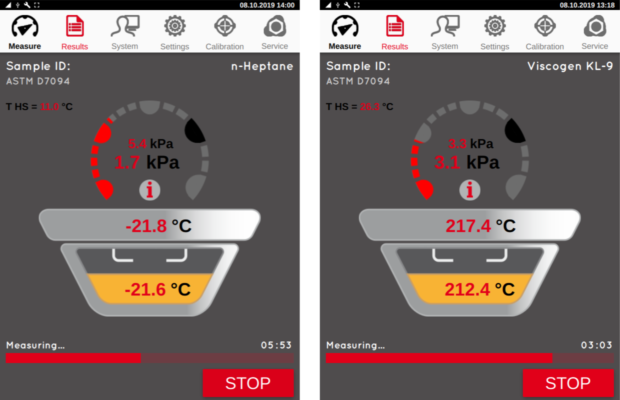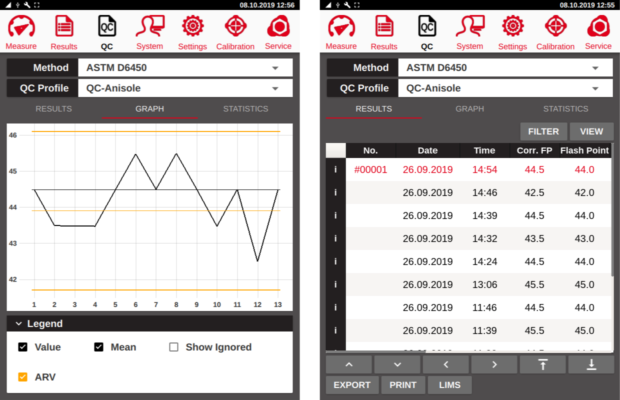eraflash
The safest all-round flash point tester.
The flash point tester eraflash measures in full compliance with the Continuously Closed Cup flash point testing methods ASTM D6450, ASTM D7094 as well as the European equivalent IP620. ASTM D7094 shows no statistical bias to the former ASTM D93 Pensky Martens method. The sample volume is only 2 ml. During measurements an electric arc ignites the sample vapor and the analyzer determines the flash point by the pressure change inside the closed cup. Flash point testing never was safer and easier.
360° View
ASTM D7094 and ASTM D6450
ASTM D6450 was the first Continuously Closed Cup Flash Point (CCCFP) and uses 1 ml sample volume only. To further improve the correlation to the well-established ASTM D93 Pensky Martens method a modified successor method was developed.
ASTM D7094 (Modified CCCFP) uses 2 ml of sample volume and a different heating rate than ASTM D6450 with the effect that it shows no statistical bias to ASTM D93 (Pensky Martens). This was proven by an ASTM round robin test in 2004.

Fuel specifications testing
In December 2013 ASTM D7094 was accepted as the first official alternative for fuel specification testing as it gives equivalent results to ASTM D93 and even outperforms it in terms of reproducibility:
- Fuel oil (ASTM D396)
- Diesel fuel (ASTM D975)
- Gas turbine fuel oil (ASTM D2880)
- Kerosene (ASTM D3699)
- Diesel Fuel, Biodiesel Blend (ASTM D7467)

Unmatched range meets high performance
eralytics’ patented PBT – Peltier Boost Technology® allows flash point testing below 0 °C (32 °F) and above 200 °C (392 °F) with a single instrument. This technology separates the Peltier elements during the heat up from the oven to prevent any damage to them at high temperatures. Additionally the Peltier elements can be used during cool down at temperatures that would normally harm them. Thus, the turnaround time is significantly shortened. On top PBT makes eraflash the only flash point tester on the market covering a temperature range of -25 °C (-13 °F) to 420 °C (788 °F).
scroll to see more images
gallery controls

High sample throughput with minimum maintenance
The innovative PBT – Peltier Boost Technology® allows previously unmatched heating and cooling rates, which in combination with the low sample volume decreased the turnaround time significantly for flash point testing. Additionally the CPT – Contamination Prevention Technology™, which is a combination of advanced electrode protection and self-cleaning procedures, reduces the time required for cleaning and maintenance to an absolute minimum, increasing the sample throughput even further.

eraflash & Density
With the temperature-controlled x-oscillating metal U-tube technology inside, eradens xs measures density with 5-digit precision. eradens xs is also available for the direct connection with eraflash. The measured density result is available within seconds on your analyzer. Depending on your needs eradens xs provides the perfect solution across most industries, from the petroleum industry to the food, beverage, or the flavors and fragrance industry.

Quality control mode
For even more measurement comfort eralytics’ flash point testers offer a quality control (QC) mode right on the instrument. To perform efficient quality control, the user can set individual warning levels to each QC sample. If a sample is measured and the results fall outside these limits a warning is automatically displayed. Additionally, QC charts are available to easily identify long term drifts and perform statistical evaluations of results.

Measurement procedure
Just four easy steps are required for a safe flash point testing at maximum precision:
- Enter sample ID and operator name
- Select the measurement standard and add additional parameters (e.g. expected flash point)
- Fill the sample cup with sample, place the sample cup inside the measurement chamber, and close the door
- Press the RUN button
The instrument now visualizes the measurement procedure on the screen showing the sample and oven temperature as well as pressure gauge displaying the pressure increase after ignition. After the measurement the flash point temperature is corrected for the atmospheric pressure and rounded to the next 0.5 °C. The result will be saved in the corresponding result file.
Characteristics of the flash point testing can be seen in the Combustion Graphics™. This makes eraflash the ideal solution for R&D as well as quality control.
scroll to see more images
gallery controls


eraflash feature video
- Inherently safe with no open flame
- Only a very low sample volume of 1-2 mL needed
- Fully compliant with ASTM D6450, ASTM D7094, IP620
- Measurement of fuels, lubricants, fragrances, flavors, paints, …
eraflash operation video
Watch this video to get an overview on the standard operation of eraflash: From installation to measurement and some extended measuring options.
Technical Specifications
- Available Test Methods
- ASTM D6450, ASTM D7094, IP620, SH/T 0768,
US D.O.T / RCRA / NAVY and NATO reference methods - Pre-Programmed Correlation Methods to…
- Pensky Martens Closed Cup: ASTM D93, EN ISO 2719, DIN 51758, IP34, JIS K2265
TAG Closed Cup: ASTM D56
Abel Pensky Closed Cup: ISO 13736, IP170
Small Scale Closed Cup and Flash / No Flash methods: EN ISO 3679, EN ISO 3680, ASTM D3828 - Fuel Specifications (ASTM D7094)
- ASTM D396, ASTM D975, ASTM D2880, ASTM D3699, ASTM D7467
- Speed Tests
- Fast screening test programs for unknown samples
- PBT – Peltier Boost Technology®
- High speed heating & cooling
-25 °C to 420 °C (-13 °F to 788 °F) with a single analyzer - CPT – Contamination Prevention Technology™
- Advanced electrode protection and self-cleaning ignition system to minimize cleaning and maintenance
- Combustion Graphics™
- Display of combustion characteristics for contamination analysis
- QuickCal™
- In-situ calibration with eralytics unique calibration cups without the need of dismantling the instrument
- Fuel Dilution Program
- Automatic fuel dilution measurement for the analysis of used engine oils
- QC Mode
- Built-in quality control mode including on-screen QC charts
- Temperature Range
- 0 °C to 200 °C (32 °F to 390 °F) stand alone. No external cooling is required.
Down to -25 °C (-13 °F) oven temperature with external cooling
Up to 420 °C (788 °F) with optional High Temperature Module - Temperature Stability
- 0.1 °C (0.2 °F)
- Sample Troughput
- Up to 12 samples per hour
- Sample Volume
- 1 mL (ASTM D6450), 2 mL (ASTM D7094, IP620)
- Sample Cups
- Nickle plated aluminium, stainless steel cups available upon request
- Result Database
- Over 100 000 detailed test reports stored in internal memory
- Alarm Tracking
- All alarm messages are stored in the database together with the result
- Display
- Industry proven 8.4″ multilingual color touchscreen
- Languages
- English, German, French, Spanish, Russian, Chinese
Additional langages available upon request - Interfaces
- Built-in PC with Ethernet, USB and RS232 interfaces
Wifi via external USB dongle
Direct LIMS connectivity and output to printer or PC
Optional input by external keyboard, mouse and barcode / QR-code reader - Remote Control
- Remote service capability via Ethernet interface
- PC Software
- erasoft rcs – remote control Windows® software for multi-instrument remote control, convenient data transfer andresult analysis
- Operating Conditions
- Temperature range 10 °C to 40 °C
Humidity up to 90% RH, non-condensing - Power Requirements
- Auto-switching 85-264 V AC, 47-63 Hz, max. 150 W (multi-voltage power supply)
Field application: 12 V DC (vehicle battery) adapter available - Dimensions / Weight
- (W x D x H) = 24.4 x 32.9 x 34.8 cm (9.6 x 12.9 x 13.7 in) / 10.5 kg (23.1 lb)
Downloads
- eraflash Brochure English
- eraflash Series Portfolio Brochure
- eraflash Brochure French
- eraflash Brochure Spanish
- eraflash Brochure Portuguese
- eraflash Brochure Chinese
- Datasheet: erasoft RCS English
- Special Permit DOT – SP 20861
- Application Note: eraflash & fuel dilution
- Application Note: Flash Point determination in Food, Flavors and Fragrances
- Application Note: eraflash and ASTM D7094 The world’s most precise flash point tester
- Application Note: eraflash – Efficiency through maximum safety and measuring speed
- Article On “ASTM D7094 – The most precise method for closed cup flash point testing” | Petro Industry News 06/2025
- Article on “ASTM D7094 – Modified Continuously Closed Cup Flash Point Standard Accepted as a Safe Alternative Method in Various Fuel Specs”